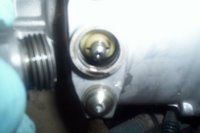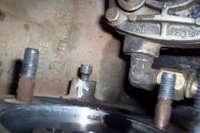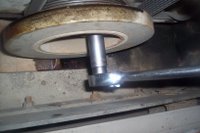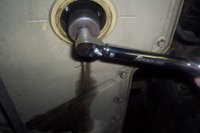In the past International DT466 Diesel Engines used 2 orings to seal the liner in the block. Here is the upgrade with the one seal. You notice we're using Lubriplate grease to pre-lube the seal. You can also use cooking oil which International recommends, all the Mechanics (myself included) in our shop swear by Lubriplate and it has never failed us.
Installing the liner is the next step.It's recommended to keep the liner seated firmly after installation as pictured here with metric fasteners and washers. The liner protrusion has to be checked as well to maintain a good seal surface for the head gasket. I hope this quick Mechanic information tidbit helped you out.
Mechanical Repairs & Troubleshooting On Diesel Engines, School Buses and Related Operating Systems.
Showing posts with label mechanic tips. Show all posts
Showing posts with label mechanic tips. Show all posts
Thursday, August 04, 2011
International Diesel Engine Rebuild Installing Liners
Labels:school bus,repairs,diesel,engine,
DT 466E
,
dt466 engine
,
international
,
mechanic info
,
mechanic information
,
mechanic tips
,
mechanical repairs
Monday, May 23, 2011
DT 466 International Diesel Engine In-Frame - Removing Radiator Assembly.

The International DT 466E Diesel Engine that's running in a school bus is more accessible by first removing the hood as in the previous post. The Mechanic does not need to be standing on his head to dis-assemble everything.
The radiator assembly comes out as a unit. You can see from the photo these models have a split radiator and charge air cooler. You might think half of a normal radiator might cause a problem but we have not experienced anything major besides deterioration over time of the radiator core. Usually they cannot be repaired and a complete unit needs to be installed in case of any failure. This radiator had been replaced not too long ago so all a Mechanic has to do is remove the radiator and send it out to be flushed and checked at a radiator shop.
Thinking ahead is a good practice for any Mechanic performing a major overhaul like this one. The radiator, turbo, oil cooler, water pump, charge air cooler and cylinder head all needs to be inspected carefully right away and either sent out or repaired which ever is the most practical. Stand by for more Mechanic Information on our in-house DT 466 International Diesel Engine Rebuild.
Labels:school bus,repairs,diesel,engine,
die diesel e diesel engines
,
diesel mechanic information
,
DT 466E
,
DT466 diesel engine
,
dt466 engine
,
fleet Mechanic
,
international school bus
,
mechanic information
,
mechanic tips
,
radiator
Monday, May 09, 2011
STN Going Social With Mechanic & School Bus Industry News
School Transportion News has a new social network that covers everything imaginable in the school bus transportation industry. I especially enjoy the TechNet section which covers school bus repairs and new technology. This is a discussion group that anyone can join and participate in with questions and answers as well as comments.
With changing technology it's essential to keep in contact with other professionals in the field and share ideas and answers to challenges encountered on a regular basis.
Here's the link if you want to check it out. I highly recommend this site for up to date knowledge and a free ticket to rub elbows with an experienced group of school bus mechanics willing to share their knowledge.
http://www.stnonline.com/social
With changing technology it's essential to keep in contact with other professionals in the field and share ideas and answers to challenges encountered on a regular basis.
Here's the link if you want to check it out. I highly recommend this site for up to date knowledge and a free ticket to rub elbows with an experienced group of school bus mechanics willing to share their knowledge.
http://www.stnonline.com/social
Labels:school bus,repairs,diesel,engine,
diesel mechanic information
,
mechanic info
,
mechanic information
,
mechanic tips
,
mechanic troubleshooting
,
saf-t-liner
,
school bus
,
school bus fleet
,
schoolbus safety
,
stnonline
,
stnsocial
Saturday, January 29, 2011
Cummins Diesel Engine Fuel Injection Pump Installation
 The Cummins Diesel [Engine Model 'C'] fuel injection pump has been repaired, but there are still a few steps to take.
The Cummins Diesel [Engine Model 'C'] fuel injection pump has been repaired, but there are still a few steps to take.
TIMING FUEL INJECTION PUMP:
The fuel injection pump MUST be timed by removing threaded hex cap located on the throttle shaft side of the housing. Remove timing pin from access hole and rotate the pump by hand until the timing tooth inside pump housing lines up with the middle of the access hole.
Engage slotted timing pin as the picture above shows. Install threaded cap hand tight until after injection pump is installed. The injection pump is now in the proper timed position.

PRE-LUBE INJECTION PUMP:
When a repair has been made on these pumps they must be pre-lubed with engine oil. Remove top plug from the governor housing with an Allen wrench. This particular model requires .71 Litres [24 oz.] . Failure to do this could cause damage during start-up.


TIMING THE ENGINE:
The next step is to time the engine by rotating clockwise [viewed from the front] while pushing on timing pin until it engages into the camshaft gear. Engine is now properly timed, the fuel injection pump is ready to INSTALL.
 After the 4 mounting bolts are tightened, torque accessory drive gear retaining nut to 106 in. lbs. then DISENGAGE BOTH TIMING PINS. The injection pump timing pin just pulls out, flips around and stays installed on the pump for next time. The engine timing pin just pulls back and stays put.
After the 4 mounting bolts are tightened, torque accessory drive gear retaining nut to 106 in. lbs. then DISENGAGE BOTH TIMING PINS. The injection pump timing pin just pulls out, flips around and stays installed on the pump for next time. The engine timing pin just pulls back and stays put.
TORQUE DRIVE GEAR RETAINING NUT:
Now it's time for the final torque 144 ft. lbs. NOTE: torque specs will vary depending on the injection pump model. Now it probably makes sense to you why it's important to disengage both timing pins. They will sheer off very easily being made out of plastic and debris will get into the injection pump housing or engine timing gear housing.


BLEEDING THE FUEL INJECTION SYSTEM:
Once the lines, linkages and accessories have been assembled it's time to bleed the system. Loosen bleeder plug located on the engine side of the injection pump. Operate transfer pump by hand until all air has been bled out of bleeder plug. Tighten bleeder plug.
Crack as many injector lines as you can at each cylinder and crank over engine until there is evidence of fuel at each injector. Stop cranking and tighten injector lines, start cranking engine once again and before you know it you'll have a smokin' diesel engine!
Labels:school bus,repairs,diesel,engine,
cummins diesel motors
,
cummins diesel repair
,
cummins engine repair
,
fleet Mechanic
,
mechanic info
,
mechanic information
,
mechanic tips
,
mechanical repairs
Saturday, January 01, 2011
Bleeding A Diesel Fuel System - Mercedes MBE 900 Diesel Engine
Here's a short video on bleeding the fuel lines on a Mercedes MBE 900 diesel engine. I'm using a tool made by Kent Moore with quick couplers that makes this a simple process. In 2006 we received 6 of these engines that didn't come with these couplers and at the same time the fuel sender wasn't accurate. There is a technical service bulletin that explains how to test the fuel tank sender from the OEM (Thomas Bus) or the operator will notice the fuel gauge is off track.
It was no surprise when we had a few incidents of buses running out of fuel. Back then all we could do was crank over the engine and crack one of the fuel lines or lightly pressurize the fuel tank to get the engine fuel system bled properly. Eventually we ordered the bleeding coupler kits and improvised a steel tank and hose slightly pressurizing it with shop air which worked great, but a little crude.
The Kent Moore J-47912 tool was the answer, sometimes it pays to give the fuel system a quick bleed after replacing fuel filters during a service.
It was no surprise when we had a few incidents of buses running out of fuel. Back then all we could do was crank over the engine and crack one of the fuel lines or lightly pressurize the fuel tank to get the engine fuel system bled properly. Eventually we ordered the bleeding coupler kits and improvised a steel tank and hose slightly pressurizing it with shop air which worked great, but a little crude.
The Kent Moore J-47912 tool was the answer, sometimes it pays to give the fuel system a quick bleed after replacing fuel filters during a service.
Labels:school bus,repairs,diesel,engine,
bleeding diesel engines
,
bleeding diesel fuel system
,
bleeding diesel fuel systems
,
kent moore j-47912
,
mechanic tips
,
mercedes mbe 900 diesel engine
Subscribe to:
Posts
(
Atom
)


